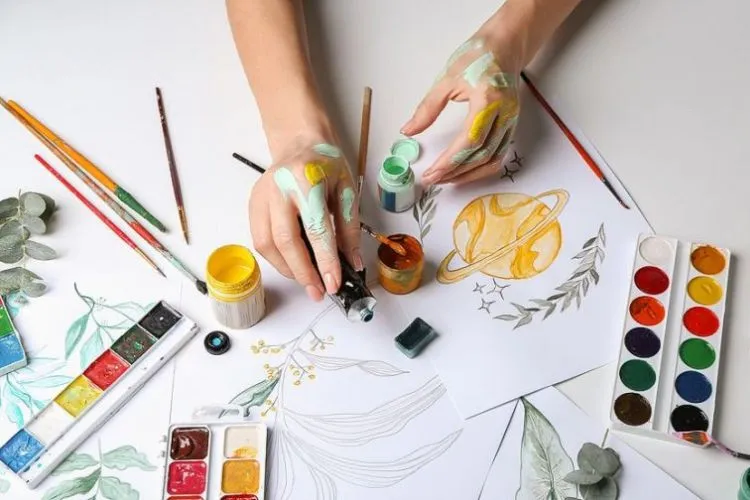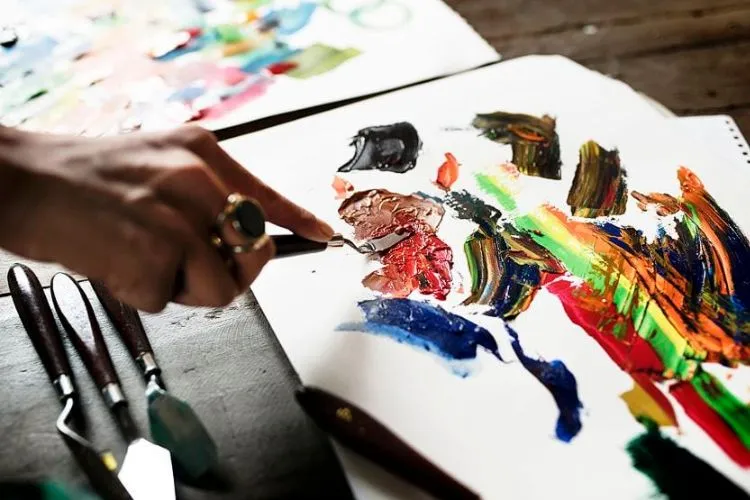Acrylic paint enjoys widespread popularity among artists and DIY enthusiasts. Its quick drying time and versatility make it a go-to choice for a variety of projects. However, one issue that can frustrate users is paint bleeding. So, does acrylic paint bleed?
This occurs when paint seeps beyond its intended borders, blurring lines and details. This article explores the causes, prevention measures, and solutions for acrylic paint bleeding.

Does Acrylic Paint Bleed?
The main factors that contribute to acrylic paint bleeding include the nature of the painting surface, the thickness of the paint, and the application method. Different surfaces absorb paint in unique ways.
For example, porous surfaces like paper absorb paint quickly, leading to bleed. In contrast, non-porous surfaces like plastic might cause paint to spread uncontrollably. The paint’s viscosity also plays a role.
Thin, watery paint is more likely to bleed than thicker paint. Lastly, how the painter applies the paint can affect bleeding. Heavy-handed application or excessive layering can exacerbate the issue.
How to Prevent Acrylic Paint Bleeding on Fabric
Fabrics pose a unique challenge for acrylic painting because of their texture and absorbency. Preparing the fabric is a critical first step. Washing and drying the fabric removes any sizing, improving paint adhesion.
Artists often mix acrylic paint with a fabric medium to enhance flexibility and reduce bleeding. When applying paint to fabric, a light hand and minimal water use help prevent bleed.
It’s also beneficial to practice on scrap fabric to gauge how the paint behaves before commencing the final project.
Preventing Acrylic Paint Bleed on Paper and Canvas
The quality and type of paper are significant when working with acrylics. Heavier paper, specifically designed for wet media, resists bleeding better than thin paper.

Preparing a canvas involves applying a primer, such as gesso, that seals its fibers and creates a non-absorbent layer. This preparation prevents paint from seeping through.
For both paper and canvas, painting with control and precision reduces the risk of bleeding. Artists can achieve clean edges by using masking tape or liquid friskets.
Solutions for Common Acrylic Paint Bleeding Problems
Even with careful preparation, bleed can occur. However, artists can fix these issues. Applying a thin layer of gesso over the bleed area can create a new base to paint over.
If the bleed is minor, painting over it with opaque colors might be enough to cover it. Furthermore, incorporating the bleed into the design is an artful way to turn a mistake into a feature.
Using acrylic mediums to adjust the paint’s consistency can also prevent future bleeding. These mediums thicken the paint without diluting its pigment, offering more control over its application.
Must-Have Tools and Supplies for Clean Acrylic Painting
Certain tools can help artists achieve sharp lines and clean edges in their work. Brushes with stiff bristles give better control over paint application. Masking tape creates barriers, protecting areas from unwanted paint.
For detailed work, a paint pen filled with acrylic paint ensures precision. Acrylic mediums, like gel medium or modeling paste, thicken paint, making it easier to work with. These tools, when used properly, can greatly reduce the chances of paint bleed.
Pro Tips for Mastering Acrylic Paint Application
Understanding paint viscosity is key to preventing bleed. Thicker paints stay where they are put, while thinner paints are prone to spreading. Experimenting with different consistencies helps artists find the right balance for their work.
Some experienced painters suggest mixing paint with a gel medium for better control. It’s also helpful to let layers dry completely before adding new ones, as wet paint is more likely to bleed.
You may also read: Is Acrylic Paint Conductive? | Is Acrylic Paint Sticky?
Troubleshooting Bleed Issues in Different Environmental Conditions
Acrylic paint’s behavior can significantly vary under different environmental conditions. Elements such as humidity, temperature, and exposure to outdoor elements play a crucial role in how paint performs, potentially leading to issues like bleeding.

Understanding these factors and knowing how to mitigate their effects can be essential for artists and DIY enthusiasts alike.
Humidity’s Impact on Acrylic Paint Bleed
High humidity levels can increase the drying time of acrylic paint, making it susceptible to bleeding for a longer duration. The moisture in the air keeps the paint wetter for an extended period, enabling it to spread beyond intended borders.
Conversely, very low humidity can make the paint dry too quickly, possibly leading to uneven application and texture, which might indirectly contribute to bleeding when trying to apply subsequent layers.
Mitigation Strategies:
- Try to paint in an environment where you can somewhat control the humidity. Dehumidifiers can help reduce moisture in the air in damp conditions.
- If dealing with low humidity, use a slower drying medium mixed with your acrylics to extend the working time and prevent too-fast drying.
Temperature Effects
Extreme temperatures, both hot and cold, can affect paint viscosity and drying time. In very hot conditions, paint may dry too quickly, making it difficult to work with and potentially causing bleeding as you attempt to layer or blend.
Cold temperatures can slow down the drying process, similar to the effects of high humidity, making the paint more prone to bleeding.
Mitigation Strategies:
- Paint in a climate-controlled environment whenever possible.
- If working in cold conditions, consider using a fast-drying medium to help the paint set more quickly.
- In hot settings, keep your paintwork shaded and use a retarder medium to slow down the drying time.
Exposure to Outdoor Elements
When painting outdoors or on surfaces that will be exposed to the outdoors, factors such as wind, sunlight, and precipitation can contribute to bleeding.
Wind can cause rapid drying, sunlight can affect the color and drying speed, and precipitation can make the paint run if not properly sealed.
Mitigation Strategies:
- For artworks meant to be displayed outside, apply a suitable outdoor varnish that provides UV protection and is waterproof to protect against bleeding caused by the elements.
- When painting outdoors, position your workspace to minimize direct exposure to sunlight and wind. Use physical barriers or choose a shaded, sheltered spot.
- Consider the forecast and environmental conditions before starting your project. It might be best to avoid painting on very windy or rainy days.
Frequently Asked Questions (FAQs)
Does acrylic paint bleed when it rains?
Acrylic paint is water-resistant once it is dry, but not entirely waterproof. If acrylic paint on outdoor items has not been properly sealed, heavy rainfall can cause the paint to become saturated and bleed. It is recommended to use a waterproof sealant for outdoor acrylic painted items.
Can you stop acrylic paint from bleeding after it’s dry?
Once acrylic paint has dried and bled, it cannot be reverted. However, you can correct the bleeding by painting over the affected area with opaque paint or using an additional layer of gesso to close the bleed and repaint the section. Unfortunately, reversing bleed in fully dried paint directly is not possible.
What surfaces are most prone to acrylic paint bleeding?
Surfaces that are highly absorbent such as untreated canvas, paper, and wood are most prone to acrylic paint bleeding. Porous materials absorb liquid quickly, causing the paint to spread outwards from the application point, resulting in bleed. Using an appropriate primer or sealant can help reduce this effect.
Advanced Techniques to Prevent Acrylic Paint Bleeding
For artists looking to elevate their painting skills and avoid paint bleeding, here are some advanced techniques:
Using Retarder Mediums: Retarder mediums are additives that slow down the drying time of acrylic paint. This allows for smoother blending and prevents the paint from drying too quickly, reducing the likelihood of bleeding.
Apply the retarder medium sparingly, as overuse can alter the paint’s consistency.
Utilizing Glazing Techniques: Glazing involves applying thin, transparent layers of paint over a dry base layer.
This technique not only adds depth and richness to the colors but also minimizes bleeding by ensuring each layer dries thoroughly before the next application.
Dry Brushing: Dry brushing is a technique where a minimal amount of paint is loaded onto a dry brush.
This method creates a textured effect with a controlled application of paint, reducing the risk of bleed. It’s particularly effective for adding highlights and details.
Splattering and Sponging: Splattering and sponging techniques involve applying paint in a way that creates controlled patterns and textures.
These techniques can be used creatively to incorporate bleeding into the design or to achieve unique visual effects without compromising the overall look of the painting.
Layering with Patience: Patience is key when it comes to layering acrylic paint. Allow each layer to dry completely before applying the next one.
Use a fan or hairdryer on a cool setting to speed up the drying process if needed, but avoid using high heat, as it can cause cracking.
Exploring Different Types of Primers
Priming your surface correctly is crucial in preventing paint bleed. Here are some types of primers you can use based on the surface you are working on:
Gesso: Gesso is a versatile primer that works well on canvas, wood, and paper. It creates a smooth, non-absorbent surface that prevents paint from seeping through. Gesso also improves paint adhesion and enhances the vibrancy of the colors.
Acrylic Primer: Acrylic primers are specifically formulated for use with acrylic paints. They provide excellent adhesion and create a barrier that prevents bleeding on porous surfaces.
They are ideal for priming walls, wood, and other surfaces intended for acrylic painting.
Oil-Based Primer: Oil-based primers are suitable for surfaces that will be exposed to moisture or outdoor elements. They provide a durable and water-resistant base, preventing bleeding and protecting the underlying material from damage.
Shellac-Based Primer: Shellac-based primers are excellent for sealing porous surfaces and preventing stains from bleeding through. They dry quickly and adhere well to a variety of materials, including wood, metal, and plastic.
Creating Custom Stencils and Masks
Using stencils and masks can help achieve clean lines and prevent bleeding in detailed areas of your painting:
Making Custom Stencils: Create custom stencils using stencil sheets or adhesive vinyl. Design your stencil, cut it out with a precision knife or cutting machine, and apply it to the surface.
This technique ensures sharp edges and prevents paint from spreading beyond the intended areas.
Using Liquid Masking Fluid: Liquid masking fluid is a latex-based product that can be applied to areas you want to protect from paint.
Once dry, it forms a rubbery layer that can be easily peeled off after painting. This technique is perfect for preserving intricate details and preventing bleeding.
Masking Tape Techniques: Use high-quality masking tape to create clean, straight lines. Press the tape firmly to ensure a tight seal and prevent paint from seeping underneath.
Remove the tape carefully while the paint is still slightly wet to avoid lifting the paint along with the tape.
Conclusion:
In conclusion, while acrylic paint bleeding can be a nuisance, understanding its causes and employing strategic prevention techniques can mitigate the issue. From choosing the right surface to mastering paint application, each step offers an opportunity to improve.
Remember, every artist encounters challenges, but it’s how they overcome them that defines their skill and creativity. Experiment, learn from mistakes, and evolve your techniques for clean, vibrant acrylic paintings.

Meet Isabella Anderson, your acrylic painting mentor with over a decade of brush-wielding mastery. Dive into the colorful world of acrylics with her expert guidance, featured exclusively on ‘Acrylic Authority.’ Unleash your inner artist and explore the limitless possibilities of this versatile medium alongside a true acrylic aficionado.
